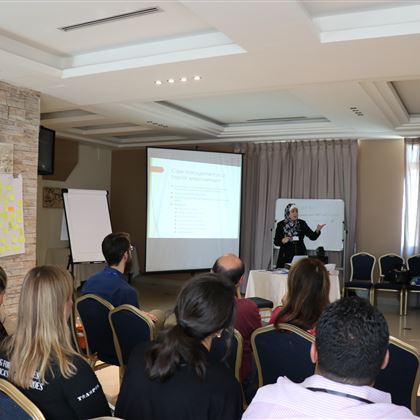URI MENA participated in the 6th Annual International Conference on Transgenerational Trauma (from 12-14 October 2017) in Amman. The conference was sponsored by Common Bond Institute (CBI) and co-sponsored by: Michigan State University (MSU), International Humanistic Psychology Association (IHPA), Yarmouk University (YU), Queen Rania Center for Jordanian Studies, and International Federation of Medical Student Associations in Jordan. Official Partners: Charter for Compassion, and Parliament of World’s Religions. The program. The conference comprised several interactive workshops covering the following topics: Nonviolent Communication: A Compassionate Way of Living and Addressing Conflict, by Ms.Tanya Awad Ghorra, MBA. The session meant to help us to rediscover our natural gifts: compassion, empathy and love as social creatures. We learnt how to communicate using our major gift properly all the time by practicing the four components of NVC:
· Observation: how to observe the facts (what we are seeing, hearing, or touching) as distinct from our evaluation of meaning and significance.
· Feelings: understand emotions or sensations, free of thought and story.
· Needs: understand universal human needs, as distinct from particular strategies for meeting needs.
· Request: request for a specific action, free of demand.
Also, it tackled three aspects of communication: self-empathy, receiving empathically, and honest self-expression. At the end of the workshop we became aware of the fact that Non Violent Communication enhances the authenticity in our communication, increased understanding, deepening connection and conflict resolution. It is so important to understand that our actions are a strategy to meet our needs which are not negative; not linked to others; and they are universal. If we learn to value our needs and those of others through empathy and compassion, we become better communicators and better resolve conflicts because our biases and our fear won’t be leading us anymore; only for love and humanity Community Circles for Addressing Historical Trauma, by Mr. Myron Eshowsky, M.S. Presenter presented a brief review of indigenous circle models (group treatment) used to address communal trauma in the United States, Canada, and Australia. Afterwards, participants practiced this models to experience being in a circle. We processed the group’s experience of being in a circle and discussed some of the challenges in group work with historical trauma. The Experiential Communication Process: Healing the Stereotypes that Wound, by Kirk Schneider, Ph.D This workshop introduced a “whole person to whole person” approach to healing cultural or religious divides. The approach draws from depth-existential principles of therapeutic practice and stresses experiential skill-building through demonstrations, breakout groups, discussion, and time permitting. Art Therapy: An Innovative Treatment of Trauma, by Shireen Yaish, MA The presenter presented her work of Art Therapy in Gaza with Mercy Corps Psychosocial Team- followed by an experiential Art Therapy Group. The participants engaged in practical exercise to express their feelings by art. This experiential workshop gave a taste to intensity of art therapy and its healing qualities. Empowering Refugee Women And Girls Facing Trauma in The Middle East, by Ayat Nashwan, PhD. The presenter featured guiding principles for working with women and girl survivors of Gender Based Violence (GBV) in a refugee context. Including an exploration of the main challenges and obstacles faced by social workers in international NGO interventions and programs. She shed lights on the effect of trauma on the case management process for survivors of GBV. Practical Applications for Trauma Recovery and Renewal at the Large Scale, by Steve Olweean, MA, Myron Eshowsky, MA, Ayat Nashwan, PhD, Ayda Alavi, BS Drawing from Common Bond Institute’s collaborative service model and current programs being implemented in Jordan, examples were offered of integrated, community-based, and local capacity building initiatives and pilot demonstration projects designed to serve large scale trauma recovery needs in regions of turmoil where there are scarce material and skill resources. Trauma Therapy with Children by Erica Serlin Ph.D. This workshop introduced participants to play therapy interventions, since children show more than they can tell as they express their pain and heal from trauma. Attendees learnt specific techniques for creating safety, expressing feelings, self-calming, and resolving trauma as well as strategies for reducing symptoms. Collective And Intergenerational Trauma Integration – Timeless Mystical Wisdom And Modern Psychology, by Nicholas Janni, BA Introduced the Pocket Project. Tackled issues and techniques such as The effects of collective trauma, Large group shadow work, Timeless wisdom & psychology, Experiential exercise in groups of three, and Deepening our self-contact. Using the Arts to Work with Trauma: KinAesthetic Imagining, by Ilene Serlin, PhD, BC-DMT We learnt about theory and research on the use of the arts to work with trauma. We experienced a method called KinAesthetic Imagining, a movement-based creative arts therapy, and explore ways in which KinAesthetic Imagining can be incorporated into our work. Bodypolitics: The Impact of Bodywork to Support Democratic Agency, by Beatrice Schlee, PhD We learnt how body remembers all experiences of our life. Yet this legacy is mutable. Like neuroplasticity does in the brain new, positive experiences can be inscribed into the memory of our body. A theoretical input into embodiment research and presenter own bodymemory work with refugees and locals in German refugee camps were presented. Teddy Bear Trauma Reduction Program, by Peter Breen, MSW LCSW This workshop addressed the symptoms of trauma, obvious and not, observable in children of various ages who have lived through repeated traumatic events. Discussions on how to use the Teddy Bear as a therapeutic tool in a variety of ways. Using experiential exercises, participants better understood the anxiety reducing attributes of a Teddy Bear and how to soothe and support the child’s defense mechanisms.
